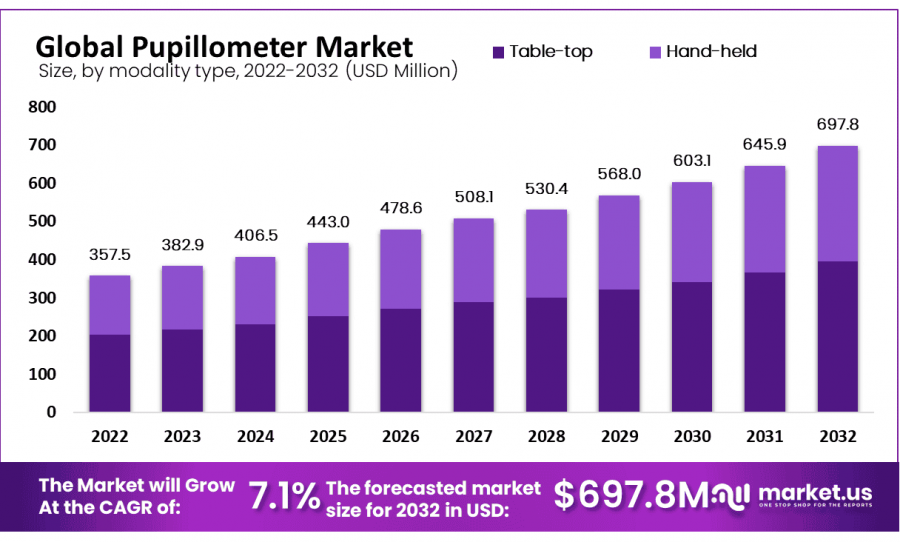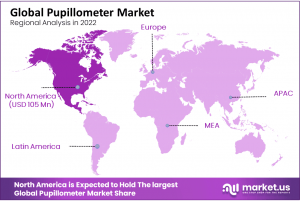
Pupillometer Market Set For Strong Growth, Expected To Reach USD 697.8 Million By 2032
Global Pupillometer Market size is expected to be worth around USD 697.8 Million by 2032 from USD 382.9 Million in 2023, growing at a CAGR of 7.10%
NEW YORK, NY, UNITED STATES, February 3, 2025 /EINPresswire.com/ -- Report Overview
Global Pupillometer Market size is expected to be worth around USD 697.8 Million by 2032 from USD 382.9 Million in 2023, growing at a CAGR of 7.10% during the forecast period from 2023 to 2032.
A pupillometer is a medical device used to measure the size and reaction of the pupils in response to light, which can provide valuable diagnostic information about a patient's neurological and ocular health. By analyzing pupil dilation and constriction, a pupillometer can help detect abnormalities such as brain injuries, concussions, or conditions like glaucoma, optic neuropathy, and neurological disorders.
The device works by emitting light into the eye and recording the pupil’s response, with readings typically displayed on a digital screen for precise analysis. Pupillometers are increasingly used in both clinical and emergency settings, allowing healthcare professionals to quickly assess a patient’s condition, especially when neurological concerns are suspected.
With advances in technology, modern pupillometers offer features such as non-invasive measurements, portability, and high accuracy. As a result, they are becoming an essential tool in hospitals, clinics, and trauma centers for improving patient outcomes and facilitating early diagnosis of serious conditions.
This annual report offers a comprehensive analysis of the global Pupillometer market, providing valuable insights into future developments. By evaluating the historical and current dynamics of the Pupillometer industry, the report includes a detailed forecast to inform key stakeholders. The Pupillometer market report is designed to assist businesses in identifying and capitalizing on opportunities, while understanding key drivers, restraints, risks, and emerging trends. It also explores how time-sensitive factors impact the market under varying assumptions.
Unlock Competitive Advantages With Our PDF Sample Report https://market.us/report/pupillometer-market/request-sample/
Key Takeaways
1. Pupil Assessment: Pupillometers are essential tools for accurately and objectively measuring pupil size, shape, and reactivity, offering crucial diagnostic information about an individual's neurological and ophthalmological health.
2. Neurological Applications: These devices are extensively used in neurology to monitor changes in pupil size and reactivity, aiding in the detection of neurological conditions such as brain injuries, brainstem dysfunction, or changes in intracranial pressure.
3. Ophthalmological Uses: Pupillometers assist eye care professionals by assessing pupillary function and diagnosing eye conditions such as glaucoma or detecting the effects of drugs on eye health.
4. Critical and Emergency Care Medicine: In critical and emergency care, pupillometers help monitor patients in intensive care units and evaluate neurological status following trauma or surgery, ensuring timely medical interventions.
5. Quantitative Pupil Assessment: Pupillometers provide precise, quantitative measurements of pupil size and reactivity, eliminating subjectivity and improving the accuracy of eye and neurological evaluations.
6. Rapid and Non-Invasive: Pupillometry offers a fast, non-invasive testing procedure that is suitable for a wide range of clinical settings, making it ideal for both routine and emergency use.
Scope of the Report:
The global Pupillometerindustry report provides insights into production, consumption, and revenue data across various regions. This research report offers a comprehensive market evaluation, covering future trends, growth drivers, key insights, and verified industry data. It also highlights market share and growth rates across major regions.
Key market players and manufacturers are included in the report, offering a detailed analysis of industry trends and strategic developments. The findings enhance market understanding, enabling informed decisions related to geographical expansion, capacity growth, and new opportunities. The primary market drivers focus on global business expansion. Additionally, the report presents trends, advancements, material insights, technological developments, and the evolving market structure.
Key Highlights of the Pupillometer Market Study
The insights presented in this report offer critical statistical data and key figures, enabling stakeholders to evaluate market trends, strategize effectively, and enhance their competitive ranking. Researchers have conducted a thorough Strengths, Weaknesses, Opportunities, Threats (SWOT) analysis, along with identifying major challenges to provide a comprehensive market assessment. Additionally, experts have utilized PESTEL analysis and Porter’s Five Forces framework to examine external market influences. By combining quantitative and qualitative research approaches, this study provides a deeper understanding of the Pupillometer market, helping businesses establish a strong market presence.
Market Segments:
Based on Modality Type
•Table-top
•Hand-held
Based on Type
•Video
•Digital
Based on Application
•Ophthalmology
•Neurology
•Oncology
•Other Applications
Based on End-User
•Hospitals
•Eye Clinics
•Other End-Users
Buy This Premium Research Report@ https://market.us/purchase-report/?report_id=100383
Market Dynamics
Driver: The rising incidence of neurological and ophthalmic conditions is a significant driver for the pupillometer market. Neurological disorders such as brain injuries, concussions, and changes in intracranial pressure often manifest with altered pupil responses, making pupillometry a valuable diagnostic tool.
Similarly, ophthalmic conditions like glaucoma and optic neuropathy can be detected through abnormal pupil reactions. The ability of pupillometers to provide rapid, non-invasive, and accurate assessments of pupil size and reactivity enhances their utility in diagnosing and monitoring these conditions, thereby driving market growth.
Trend: There is a growing trend towards integrating pupillometry into emergency and critical care settings. Pupillometers are increasingly used to assess neurological status in patients following trauma or surgery, aiding in the early detection of neurological deterioration. Their non-invasive nature and ability to provide immediate results make them valuable in intensive care units and emergency departments, where rapid decision-making is crucial. This integration is expected to expand as healthcare providers seek efficient tools for patient monitoring.
Restraint: A notable restraint in the adoption of pupillometers is their high cost and limited accessibility, particularly in resource-constrained settings. The advanced technology and precision engineering involved in manufacturing pupillometers contribute to their expense. This can limit their availability in certain healthcare facilities, especially in developing regions. Additionally, the need for specialized training to operate these devices effectively can further restrict their widespread use.
Opportunity: Advancements in technology present significant opportunities for the pupillometer market. The development of portable, user-friendly, and cost-effective pupillometers can enhance their adoption across various healthcare settings, including primary care and emergency services. Integrating pupillometry with other diagnostic tools and electronic health records can streamline patient assessment and monitoring. Expanding the application of pupillometers to include monitoring of conditions like sleep disorders and cognitive impairments also offers new avenues for market growth.
Key Objectives Of The Pupillometer Global Market:
• To analyze the global Pupillometer market consumption, industry size estimation, and forecast.
• To understand the general trends of the global Pupillometer market by understanding its segments and sub-segments.
• Focuses on the leading manufacturers of the Global Pupillometer market to analyze, describe and develop the company's share, revenue, market value, and competitive landscape of the company over the years.
• To analyze the Pupillometer market in terms of upcoming prospects, various growth trends, and their contribution to the international market.
• To analyze the production/consumption analysis of the global Pupillometer market with respect to key regions.
• To get detailed statistics about the key factors governing the growth potential of the global Pupillometer market.
Key Market Players:
•NeurOptics Inc.
•Adaptica
•Essilor Instruments USA
•HAAG-STREIT GROUP
•Johnson & Johnson Vision
•Luneau Technology Group
•NIDEK CO. LTD.
•Reichert Technologies
•SCHWIND eye-tech-solutions
•US Ophthalmic
•Konan Medical
•Brightlamp Inc.
•Other Key Players
Regional Analysis:
• North America (Panama, Mexico, Barbados, United States, Canada, Puerto Rico, Trinidad, and Tobago, etc).
• South and Central America (Brazil, Chile, Argentina, Belize, Costa Rica, Panama, Guatemala, El Salvador).
• Europe (Spain, Belgium, France, Holland, Germany, Sweden, Switzerland, San Marino, Ireland, Norway, Luxembourg, etc).
• Asia-Pacific (Qatar, China, India, Hong Kong, Korea, Israel, Australia, Singapore, Japan, Kuwait, Brunei, etc.).
• The Middle East and Africa (United Arab Emirates, Egypt, Algeria, Nigeria, South Africa, Angola, Saudi Arabia, Bahrain, Oman, Turkey, Lebanon, etc.).
Key questions answered in the report include:
• What are the key factors driving the Pupillometer market?
• What was the size of the Emerging Pupillometer Market in 2024?
• What will be the size of the Emerging Pupillometer Market in 2033?
• Which region is projected to hold the highest market share in the Pupillometer market?
• What is the market size and forecast of the global Pupillometer market?
• What products/segments/applications/areas will be invested in the Global Pupillometers Market during the forecast period?
• What are the technological trends and regulatory framework of the Global Pupillometer market?
• What is the market share of the key vendors in the global Pupillometer market?
• What are the right modes and strategic moves to enter the Global Pupillometer Market?
Reasons to Acquire This Report
- Provides a comprehensive industry outlook, covering global market trends and high-growth segments.
- Includes market share analysis of leading players, company profiles, and critical industry insights.
- Identifies emerging trends, high-growth regions, and market drivers, restraints, and opportunities.
- Examines the latest technological advancements and innovations across various industries.
- Estimates current market size and future growth potential across key applications and industries.
Lawrence John
Prudour
+91 91308 55334
email us here
Distribution channels: Healthcare & Pharmaceuticals Industry
Legal Disclaimer:
EIN Presswire provides this news content "as is" without warranty of any kind. We do not accept any responsibility or liability for the accuracy, content, images, videos, licenses, completeness, legality, or reliability of the information contained in this article. If you have any complaints or copyright issues related to this article, kindly contact the author above.
Submit your press release


